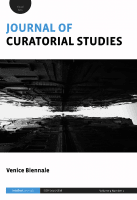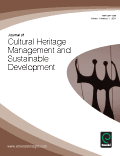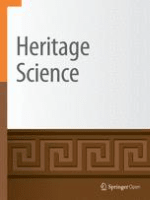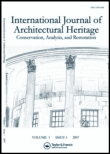
Conservation Science in Cultural Heritage
Scope & Guideline
Fostering Collaboration for Lasting Preservation
Introduction
Aims and Scopes
- Heritage Conservation Techniques:
Focuses on innovative methodologies for the conservation of various forms of cultural heritage, including architectural, archaeological, and artistic works. This includes non-destructive testing and digital modeling techniques. - Digital Documentation and Technology:
Explores the use of digital technologies, such as 3D scanning, photogrammetry, and AI, to document and preserve heritage sites and artifacts. This reflects a growing trend towards integrating technology in heritage management. - Cultural Heritage Management:
Investigates strategies for effective management of cultural heritage resources, including community involvement and sustainable tourism practices. This aims to balance preservation with public engagement. - Interdisciplinary Approaches:
Encourages collaboration across disciplines such as art history, archaeology, architecture, and environmental science to enrich the understanding and preservation of cultural heritage. - Cultural Identity and Heritage:
Examines the relationship between cultural heritage and identity, focusing on how heritage influences and reflects local and national identities.
Trending and Emerging
- Artificial Intelligence in Conservation:
The use of AI technologies in art and heritage preservation is gaining momentum, illustrating a trend towards employing advanced analytics and machine learning to enhance conservation efforts and improve documentation processes. - Digital Heritage and Virtual Reality:
There is a noticeable increase in research focusing on digital heritage, including virtual reality and digital twin technologies, which offer innovative ways to engage with and preserve cultural sites. - Sustainable Tourism Practices:
Emerging studies emphasize the importance of sustainable tourism as a means to protect cultural heritage while promoting local economies, reflecting a growing awareness of the need for responsible heritage management. - Community Engagement in Heritage Preservation:
Recent papers highlight the significance of involving local communities in the conservation process, indicating a shift towards participatory approaches that empower stakeholders in heritage management. - Cross-Cultural Studies and Global Perspectives:
The journal is increasingly featuring studies that explore cross-cultural influences and global perspectives on heritage, underscoring the interconnectedness of cultural narratives in a globalized world.
Declining or Waning
- Traditional Conservation Methods:
There seems to be a decreasing emphasis on conventional conservation practices, as newer technologies and methodologies gain traction in the field, indicating a shift towards more innovative and technology-driven approaches. - Historical Contextual Studies:
Research focusing solely on historical aspects without integration into contemporary conservation practices is becoming less frequent, suggesting a move towards studies that connect past practices with current challenges. - Local Cultural Practices:
While still relevant, the exploration of localized cultural practices in isolation appears to be waning, with a growing preference for studies that address broader themes of globalization and transnational influences on heritage. - Environmental Impact Studies:
There is a noticeable reduction in papers specifically addressing the environmental impacts on cultural heritage, as the focus shifts towards more direct conservation strategies and technological solutions.
Similar Journals

MUSEOLOGIA SCIENTIFICA
Elevating Standards in Scientific Museum PracticesMUSEOLOGIA SCIENTIFICA is a distinguished journal dedicated to the study and advancement of museology, published by the ASSOCIAZIONE NAZIONALE MUSEI SCIENTIFICI in Italy. Focusing on a wide array of topics within the realm of science museums, the journal offers rich insights and research findings that shape the future of museum practices and education. Although currently not an open-access publication, MUSEOLOGIA SCIENTIFICA provides a vital platform for scholars, practitioners, and students interested in the preservation, curation, and display of scientific artifacts. By contributing to the discourse on innovative museum practices, the journal plays a crucial role in enhancing the professional standards within the field while promoting collaboration among museums worldwide. We invite researchers and practitioners alike to explore its valuable content, aimed at broadening understanding and knowledge in the ever-evolving landscape of museology.

Portal-Godisnjak Hrvatskog Restauratorskog Zavoda
Exploring New Horizons in Visual Arts Conservation.Portal-Godisnjak Hrvatskog Restauratorskog Zavoda is an esteemed academic journal dedicated to the fields of conservation and visual arts, published by the HRVATSKI RESTAURATORSKI ZAVOD. With its ISSN 1847-9464 and E-ISSN 1848-6681, this journal plays a critical role in disseminating pioneering research and facilitating discourse among scholars, practitioners, and students alike in Croatia and beyond. Although it currently does not operate on an open access model, the journal is recognized for its quality, evident in its Q3 ranking in Conservation and Visual Arts and Performing Arts categories as of 2023. With a focus on innovative techniques and case studies, Portal-Godisnjak contributes significantly to the body of knowledge and best practices in the conservation of cultural heritage. Its commitment to advancing the field is further highlighted by its engagement with contemporary conservation challenges and artistic preservation. The journal stands as an important resource for those invested in the stewardship and enhancement of our shared cultural legacy.

International Journal of Intangible Heritage
Championing the Preservation of Cultural Expressions.The International Journal of Intangible Heritage, published by the NATL FOLK MUSEUM KOREA-NFMK, stands as a premier platform dedicated to the exploration and preservation of intangible cultural heritage. With an ISSN of 1975-3586 and an E-ISSN of 1975-4019, this journal has successfully carved a niche in the fields of Conservation, Cultural Studies, and Museology, achieving Q1 categorization across these disciplines in 2023. It ranks impressively in Scopus, being #17/83 in Museology and #33/103 in Conservation, highlighting its significant contribution to the academic discourse in these fields. Published in South Korea, this journal not only serves as a vital resource for researchers and professionals but also engages students aspiring to enhance their understanding of intangible heritage. Accessible without an open access model, it features a blend of scholarly articles, reviews, and case studies from 2011 through 2024, making it a robust repository for current and emerging practices in the safeguarding of cultural expressions. By fostering innovative dialogue among scholars and practitioners globally, the International Journal of Intangible Heritage plays a crucial role in the ongoing dialogue surrounding the value and significance of intangible cultural assets.

Journal of Curatorial Studies
Elevating Discourse in Curatorial StudiesThe Journal of Curatorial Studies, published by INTELLECT LTD, is a leading scholarly journal dedicated to advancing the field of curatorial practice across the visual arts, museology, and conservation. With an ISSN of 2045-5836 and an E-ISSN of 2045-5844, this UK-based publication has been a vital resource since its establishment in 2016, covering significant developments and innovative research until 2023. As an academic platform, it seeks to foster interdisciplinary dialogue among curators, artists, and scholars, exploring contemporary challenges and methodologies within its scope. Ranking in the Q4 category for Conservation and Q3 for both Museology and Visual Arts and Performing Arts, the journal plays an essential role in elevating discourse and practice within these fields. Researchers and practitioners alike will find valuable insights that reflect the dynamic nature of curatorial studies and its profound influence on cultural heritage and contemporary art. Despite its recent establishment, it holds a commendable position in the Scopus Rankings, aiming to provide a rich repository of knowledge and practical guidance in its quest to innovate curatorial practices.

Journal of Cultural Heritage Management and Sustainable Development
Innovating solutions for heritage and sustainability.Journal of Cultural Heritage Management and Sustainable Development is a pioneering publication dedicated to advancing the fields of cultural heritage management and sustainable practices. Published by Emerald Group Publishing Ltd in the United Kingdom, this journal has established itself as a critical resource since its inception in 2011, with an ongoing commitment to quality research through 2024. The journal is notably recognized with a Q1 ranking in Conservation and boasts impressive Scopus rankings, highlighting its significant impact in the realm of arts and humanities. It also showcases a multidisciplinary approach, bridging gaps between business management and urban studies, thereby providing invaluable insights to researchers, professionals, and students. With diverse access options to engage a broad audience, the Journal of Cultural Heritage Management and Sustainable Development thrives at the intersection of scholarship and practical application, making it an essential read for those dedicated to fostering sustainable development in cultural heritage contexts.

Heritage Science
Leading the Way in Innovative Heritage ResearchHeritage Science is a prestigious open-access journal, published by Springer since 2013, dedicated to the fields of heritage conservation and archaeology. With an ISSN of 2050-7445, it offers a platform for innovative research and critical discussions, encompassing interdisciplinary approaches that bridge the gap between art, science, and technology. The journal proudly ranks in the Q1 category for both Archaeology (arts and humanities) and Conservation, highlighting its influence and reputation within these scholarly realms. Furthermore, its presence in Scopus with impressive percentile rankings—such as #7 in Conservation and #23 in Archaeology (arts and humanities)—asserts its role as a leading voice in heritage studies. The journal's commitment to open access enhances the dissemination of knowledge, making it an essential resource for researchers, professionals, and students engaged in the preservation and interpretation of cultural heritage. Heritage Science continues to set standards in research quality, encouraging contributions that advance the understanding and sustainability of our shared heritage.

International Journal of Architectural Heritage
Leading the Way in Architectural Heritage Research.The International Journal of Architectural Heritage is a premier publication dedicated to the multidisciplinary fields of architecture, conservation, and visual arts. Published by TAYLOR & FRANCIS INC, this journal serves as a vital platform for scholars and practitioners who aim to advance knowledge in the preservation of cultural heritage and architectural innovation. With an impressive impact factor reflecting its critical acclaim, including rankings in the top quartile (Q1) across multiple categories in 2023, the journal is recognized as a key resource in Arts and Humanities, particularly in Visual Arts and Performing Arts and Conservation. Since its inception in 2007, the journal has consistently provided rigorous peer-reviewed research, offering enriching insights and fostering collaborations amongst students, researchers, and professionals committed to the future of architectural heritage. As it continues to influence the field through its diverse and impactful contributions, readers can expect to engage with leading-edge studies that not only illuminate current trends but also inspire innovative practices in safeguarding architectural legacies.

Archeomatica-Tecnologie per i Beni Culturali
Unlocking the Future of Cultural Asset Management.Archeomatica-Tecnologie per i Beni Culturali is a prestigious open-access journal dedicated to the field of cultural heritage technologies. Published by ARCHEOMATICA, this journal prides itself on disseminating high-quality research focused on innovative methodologies and technologies that enhance the preservation, conservation, and management of cultural assets. Since its inception in 2011, Archeomatica has fostered an inclusive platform for researchers, professionals, and students to share insights and advancements in the integration of science and technology within the cultural heritage sector. With a commitment to accessibility, all articles are freely available, promoting a collaborative academic environment. This journal is essential for those interested in bridging the gap between cultural heritage preservation and technological innovation, helping to ensure the longevity of our shared history.

JOURNAL OF CULTURAL HERITAGE
Exploring the Depths of Cultural Legacy.JOURNAL OF CULTURAL HERITAGE, published by Elsevier France - Éditions Scientifiques Médicales Elsevier, is a pivotal academic journal dedicated to the multifaceted study of cultural heritage, including its conservation, anthropology, archaeology, and related fields. With an impressive standing in the academic community, this journal has achieved a Q1 ranking in Anthropology, Archaeology, Conservation, and History, reflecting its critical influence and contribution to these disciplines. The journal serves as a vital resource for researchers, professionals, and students interested in innovative research and developments concerning cultural heritage practices and policies. Although it operates under a subscription model, it provides access to innovative research and insights from the field, making it essential for those engaged in the preservation and study of cultural artifacts and historical narratives.

Mediterranean Archaeology & Archaeometry
Exploring the Depths of Mediterranean HeritageMediterranean Archaeology & Archaeometry is a premier academic journal dedicated to advancing the fields of archaeology, anthropology, conservation, and history, published by UK Zhende Publishing Ltd. With its ISSN 1108-9628 and E-ISSN 2241-8121, this journal serves as a vital platform for scholars and practitioners to disseminate innovative research and findings related to the rich archaeological heritage of the Mediterranean region. It has gained remarkable recognition, achieving a Q2 ranking in anthropology and archaeology, and a Q1 classification in several categories including arts and humanities, conservation, and history as of 2023. Its impressive Scopus rankings underscore its impact, with a significant position in history (59/1760) and conservation (11/103) disciplines. Spanning years from 2008 to 2022, the journal invites open access contributions to foster collaboration and interdisciplinary dialogue among researchers, students, and professionals alike, making it an indispensable resource for those engaged in the exploration and preservation of historical narratives within the Mediterranean context.